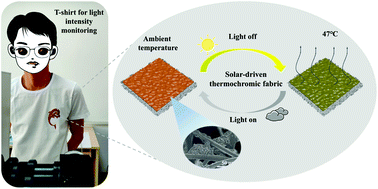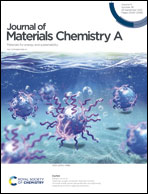Solar-driven thermochromic fabric based on photothermal conversion for light intensity monitoring†
Abstract
Considering the harm to human skin caused by excessive solar radiation, a simple method to indicate sunlight intensity and alert people instantly is needed. A solar-driven thermochromic fabric (SDTCF) with the function of light intensity monitoring is successfully constructed via printing a solar-driven thermochromic paste onto the surface of polyester fabric. With the enhancement of irradiation intensity from 100 W m−2 to 600 W m−2, the saturation temperature of the SDTCF increases sharply from 32.2 °C to 52.6 °C based on photothermal conversion. Under solar irradiation, the color of the SDTCF changes visibly from orange at ambient temperature (21.5 °C) to green (38.0 °C), which is attributed to the heat generated by photothermal conversion. The temperature decreases rapidly to ambient temperature once the light source is turned off, and the color of the SDTCF returns instantly to the initial orange. These results demonstrate that the SDTCF exhibits stable photothermal conversion and high-contrast reversible color change performance under sunlight irradiation. The SDTCF makes it possible to monitor the sunlight irradiation intensity in a timely fashion via color change for human body protection and health management. The SDTCF maintains stable solar-driven heating performance even throughout 100 heating/cooling cycles, and it shows outstanding durability against repeated bending, twisting, and stretching deformations.



 Please wait while we load your content...
Please wait while we load your content...